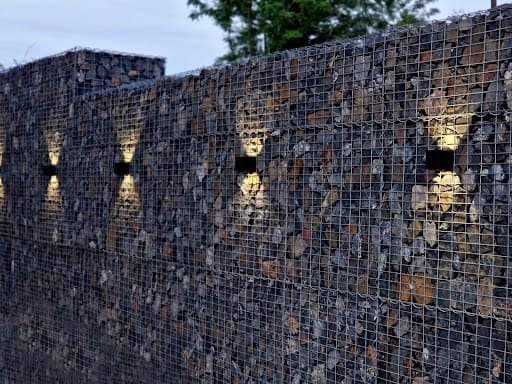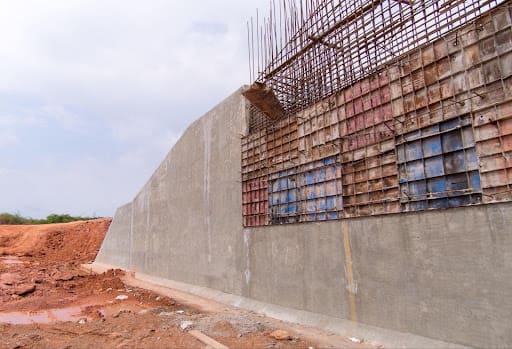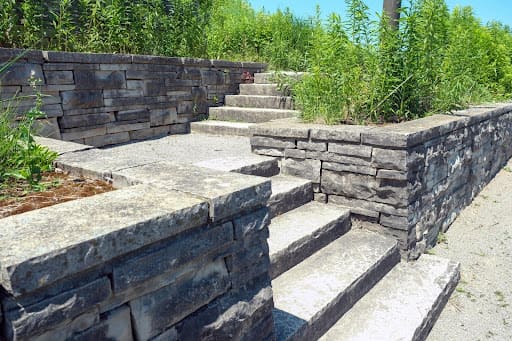A retaining wall is one of the most widely used strategies to prevent soil erosion on slope lands. The walls are available in various types, depending on the nature of the commercial, industrial, and domestic needs they serve, with considerations for durability, drainage, and stability. The article examines these walls that are most practical in different environments, the best applications of these walls, as well as the key considerations to make when choosing the most suitable solution.

Why Are These Walls Important?
The walls are about more than barriers - they are tools in strategizing land development and environmental protection. Their aesthetic value is secondary as they ensure safety, improve land utilization, and suit the strength of infrastructure under varying conditions and topography. The greatest benefit of constructing these walls is to counter lateral soil migration, especially in areas where the elevation gradient is high or in places prone to loose soils. In their absence, most of the properties and infrastructures risk erosion, encroachment, or gravity and water flow collapse. This is why these walls are necessary:
i. Soil Erosion Control
These walls get rid of the problem of soil erosion, especially in an inclined property. With time, the natural processes of rain, wind, and running water can erode unprotected slopes. These walls provide a secure boundary where soil does not easily get washed off, and there is no likelihood of the drainage systems or the water bodies being loaded with thick sediments.
ii. Elevator Manager
On hills or heavily contoured land, a retaining wall makes it possible to create flat surfaces on which home foundations, driveways, stripe patios, and gardens may be constructed. They level sloping surfaces, creating new terrains, ideal terrains to build on.
iii. Structural Support
A retaining wall is built in locations alongside highways, in basements, or in parking lots to ensure a collapse of a raised surface. The mass and reinforcement that they were designed to have, react as a counter effect on soil and water pressure. This is a structural support that is particularly very essential in earthquake-vulnerable or water-flooded areas.
iv. Flood Prevention
The use of these walls is highly fundamental in the diversion and management of surface runoffs. When used along with proper sources of drainage such as weep holes, French drains, and geotextile membranes, they are used to guide the water out of the path of the building and structural damage caused by floods and water.
v. Safety Assurance
The loose slopes may cause dangerous landslides, particularly when it rains heavily. The retaining wall plays an important safety role by keeping the embankments firm and protecting lives and property.
vi. Aesthetic and Functional Landscaping
Every retaining wall is capable of adding to the beauty of any outdoor area, whether it is stepped garden beds or terraced backyards. They bring character and definition to any landscape using a collection of materials such as stone, timber, or concrete blocks. Additionally, they are functional as seating edges, planting areas, or path supports.
vii. Increased Property Usability
A retaining wall will bring a significant improvement in the usability of the land, as it can become an area where a backyard can be expanded or even a driveway. This feature is very valuable in the city, where space is a scarce resource.
viii. Regulatory Compliance
Most building codes, as well as environmental regulations, demand erosion control, particularly around water bodies or in bigger project work. The well-designed walls ensure that developers attain these legal requirements without posing any risks to the surrounding ecosystems.
ix. Property Value Enhancement
Other than safety and functionality, these walls installed by professionals can increase property value. They enhance curb appeal, provide living square footage, and are an indicator of quality construction, all of which matter in the resale of a home. These retaining walls are necessary for each process of changing the unstable soil into safe, workable, and attractive areas. They are used in both domestic lawns and large infrastructure developments. These structures create land sustainability, risk mitigation, and success when well-planned and engineered.

Types of Retaining Walls
Retaining walls come in various forms based on the issues that a location needs to address, including topography, load-bearing capacity, environmental factors, and cost. The walls to be built can be calculated based on on-site requirements and the anticipated lifespan of the performance applied, whether it is a basic garden cover or a sophisticated infrastructure.
Gravity Walls
The gravity walls only depend on weight and mass in opposing the lateral pressure of the retained soil. The materials used in constructing these types of walls are heavyweight materials, such as stonework, high concrete blocks, or cast-in-place concrete. They are thus independent and need minimal reinforcement. The rule is simple: the pressure opposes mass. They tend to have the best center of gravity since such walls are always wider at the bottom and narrower at the top. The reason why such walls are relatively common in light commercial and residential construction is that they can be easily constructed. They can either be dry-stacked, that is, without mortar, or mortared to make them stronger and more durable.
These walls are best suited for use in areas where reinforcement or excavations are challenging. They can be used on lower-height walls, typically not exceeding 3 meters, such as on a garden terrace along a path, a driveway, or the edge of a landscape. They also look good, particularly when aesthetically fitted into green surroundings, as they resemble natural stones. Nevertheless, they are not necessarily economical or structurally adequate to handle high-load and high-wall capacity without using excessive materials.
Gabion Walls
Gabion walls are sectional structures using steel-meshed baskets filled with rock or debris. They are robust due to the weight of the fill material as well as the interlocking design of the wire mesh construction. Gabions resist the movement of the grounds or slight earthquakes, unlike the rigid walls that would fracture themselves on such vibrations. Gabions are designed to be permeable, making them suitable for use in waters with high surface runoff or near a water body. They have minimum foundation requirements and can be combined to achieve mid-level walls. As time passes, the stones can even support vegetation, which would enhance both their aesthetic and ecological value.
The gabion walls are also applicable to environmentally sensitive constructions, e.g., in the stabilization of riverbanks, shore protection, and erosion mitigation in flood-prone and steep-slope regions. This is an added advantage, as they can be easily installed in remote or rugged areas where machines are not easily accessible. Property owners appreciate the rustic look and appearance, and engineers like them because they are very durable and require minimal maintenance costs.
Cantilever Walls
Cantilever walls utilize leverage to counteract the force of the soil. They are made of reinforced concrete and have been constructed in the form of towers with a wide base slab, separated into the heel, which is found below the soil, and the toe, which is the exposed side. The design ensures that the weight of the retained soil above the heel contributes to the wall's stability. This is a professional type of wall that demands engineering and formwork. Nevertheless, when assembled, it is quite cost-effective and efficient for medium heights. The vertical face may be carved or smoothed to suit aesthetic preferences.
Cantilever walls would be most suitable where there is limited space behind the wall. Their typical applications are in highways, commercial land, and major excavations where engineered precision is of great importance. When walls are taller than 3 meters but shorter than 6 meters, cantilever walls allow a strong and cost-effective solution. They are best suited where a substantial surcharge is present near the wall, such as parked vehicles or buildings.
Counterfort Walls
Counterfort walls are an adaptive version of cantilever walls, where additional triangular-form supports called counterforts are implemented on the backside. These vertical bracing elements glue the stem and the base, reducing bending and stiffening the entire structure.
The counterfort walls are more suitable for heavy-duty infrastructure due to their added complexity and material requirements. Their performance is better at heights greater than 6 meters, where a cantilever shape would necessitate an unreasonable thickness of the wall in use or the amount of reinforcement incorporated into it.
The best applications of counterfort walls are in large projects, such as bridge abutments, expressway retention walls, water treatment plants, and deep basement foundations. They can be used to cover large walls where a consistent strength distribution is desired and where long spans are needed. Counterfort systems offer unrivaled durability and strength, making them particularly well-suited for property developers and civil engineers who face significant and complex soil retention issues where long-term performance is crucial.
Anchored Walls
Anchored walls typically use cables or steel rods that are deeply embedded in the adjacent rock or ground. Such anchors offer extra lateral earth pressure resistance, thus suitable for high loads and tall structures. Wall construction, followed by the tensioning of anchors, provides prestress, which immediately stabilizes the wall. The process can be applied to a wide range of wall systems, including sheet piles, soldier piles with lagging, and reinforced concrete panels. It entails a very high-tech geotechnical assessment and specialized construction methods, including drilling and anchoring.
Anchored walls are best applied in small spaces where standard wall foundations cannot be constructed, such as in city basements, excavation trenches, or coastal works. They thrive especially in soft soils or areas with a high water table. They are used by engineers where vertical and horizontal loads are high or the places where large retaining systems are challenging to reach. Deep excavations, mining projects, and marine structures such as ports and docks are prime examples of where anchored walls would be a prominent solution.
The terrain, load, aesthetics, and durability are a balance of skill and careful selection in choosing a suitable retaining wall. To be structurally specific, property and engineers are required to ensure the site conditions are stable, safe, and financially sound in the long term.

Choosing the Right Retaining Wall: What to Consider
The decision to use a retaining wall is not a cosmetic or convenience measure but rather something that directly affects structural soundness, future performance, and environmental stability. The type of walls should also be aligned with several factors to support the particular conditions and goals of your site.
Soil Type
The soil composition is a critical parameter in defining the behavior of the walls. Water-retentive clay soils require drainage-oriented walls, such as gabions or grouted structures, to prevent hydrostatic load. Sandy soils are lighter and well-drained and are compatible with gravity and cantilever walls that do not require excessive reinforcement. Steep ground presents superb natural assistance, making it suitable for a gravity or gabion wall, as it offers plentiful in-fill and slope stability. Unstable silty types of soils with poor drainage systems typically require engineered structures, such as anchored walls or counterfort walls, which offer robustness and flexibility against both lateral forces and water percolation.
Wall Height
Height is an important aspect that determines the structural design and the selection of materials. Gravity walls and gabions are practical and economical options for low walls up to 3 meters in height. They depend mainly on their weight and require some reinforcement. Cantilever walls are more suitable for medium-height walls with a height of 3-6 meters, as they are cost-effective and structurally favorable. Above 6 meters in wall height, sophisticated structures such as counterfort or anchored walls are required to provide both satisfactory strength and safety. The larger applications typically involve heavy embankments or high-load conditions, requiring precise engineering design and reinforced constructions to remain durable in the long run.
Underground Drainage
Drainage should be adequate to prevent water stagnation, which can cause pressure behind the wall and lead to structural collapse. Systems that utilize concrete, such as cantilever and counterfort wall structures, allow water to drain into weep holes. The use of Gabion walls allows for the natural movement of water, making them ideal for flood-prone or wet environments. Behind any wall, other drainage methods may also be employed to enhance water management, including the use of geotextile fabrics and perforated drain pipes. The use of good backfills, such as gravel or crushed stone, also ensures that the wall will have no negative impact, as the water is securely dammed off.
Aesthetics
A retaining wall is both valuable and beautiful. Gravity and gabion walls, especially those made of natural stone, have a natural look that blends in with a landscape, so they are frequently applied in residential yards and parks. The clean finish on the cantilever walls gives it a contemporary look that suits the city and business area. Concrete walls can be finished with veneer stone, brick, or decorative finishes to add visual appeal. Plants can be planted inside the gabion and gravity wall to add more green cover and make the design more environmentally friendly. The proper aesthetic decision has the power to enhance the property's value and complement the landscape.
Cost Considerations
Budget limitations broadly impact wall selection. The least expensive options include gravity and gabion walls, particularly when using local stone or recycled materials. Cantilever walls are costly since they require the use of formwork, concrete, and steel reinforcements. Counterfort and anchored walls are more expensive and offer greater strength due to their complicated design and specialized installation procedures compared to supporting walls. It is always essential to consider both long-term value and upfront costs. It involves the requirements of maintenance, the service life of the structure, as well as the probable cost of failure. A larger upfront investment into the right system can cut repair and replacement costs in the long run.
Space Considerations
The availability of site space is another factor that determines the choice of wall. Anchored and cantilever walls are suitable for confined or urban spaces, as they have small footprints and do not require a large base width. Gabion walls are not as stiff and do not suit rough topography, but due to their volume, they occupy a lot of space on their sides. In highly built-up areas where digging is restricted, anchored walls are a brilliant solution, as they can hold heavy weights with minimal visible construction. Additionally, it is easy to tailor the gabions to irregular layouts, providing increased design flexibility. Wall selection should be based on considerations of space, soil, and drainage. A balance is struck between terrains, loads, aesthetics, cost, and space to select the right retaining wall. Each of the wall types is strong in its own right and suited to address a particular issue. It is essential to consider the specific requirements of your site and how it should be adapted to wall structures that will remain stable, functional, and visually appealing in the long term.
These retaining walls are essential in both structural design and landscaping, providing solutions that balance functionality, safety, and beauty. The walls can work wonders, not only when it comes to controlling soil erosion, developing usable territory, and increasing property value, but also when taming harsh lands to create stable and appealing settings. Gravity and gabion walls are also economical types of constructions, whereas engineered ones, including cantilever, counterfort, and anchored wall types, may be tailored to specific soil conditions, intense loads, and other project constraints. A well-informed decision will result in sustainable land use, regulatory compliance, and long-term performance. Finally, thorough planning and professional design are the key determinants of a successful retaining wall venture.
